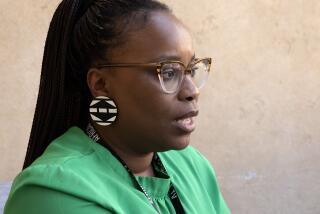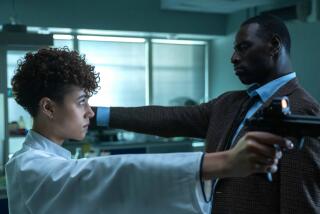Eye of the Lion Behind ‘Psycho’s’ Camera
For one night anyway, the Bates Motel looked like Chinatown on New Year’s.
When “Psycho” director Gus Van Sant was ready to start shooting at the new Bates house set last July, his production team organized a lavish feng shui ceremony designed to ward off any Hitchcockian evil spirits that might be lurking on the Universal Studios back lot. A kung fu master and his disciples blessed the house by performing a costumed lion dance in front of a Chinese temple altar. A round of firecrackers exploded in the air.
Watching the ceremony unfold, Christopher Doyle, “Psycho’s” director of photography, had the delighted look of a man who felt right at home.
“It’s something we always do on our films in China,” said the 46-year-old cinematographer, who speaks fluent Mandarin and Cantonese and has lived in Hong Kong since the late 1970s. “The offerings and the firecrackers are used to celebrate and ward off evil spirits. And you always have a lion dance because lions are considered auspicious creatures. If we were in China, we’d have sacrificed a pig too, but being my first time in Hollywood I wasn’t sure how that would go over.”
A native Australian and self-proclaimed “wild child” who is so well known in Asia that he is greeted by strangers on the street, Doyle has emerged as perhaps the most noted cinematographer of modern Asian cinema. The self-taught cameraman has won five Hong Kong Oscars for best cinematography working with such top directors as Chen Kai Ge (“Temptress Moon”), Stanley Kwan (“Red Rose, White Rose”) and Wong Kar-Wai, with whom he has made such groundbreaking films as “Chungking Express,” “Fallen Angels” and “Happy Together.”
*
Doyle’s first Hollywood effort won’t be out until “Psycho” arrives Dec. 4. But his Hong Kong films are on display from Saturday through Nov. 24 at the UCLA Film and Television Archive, which is presenting an eight-film retrospective at the Bridges Theater in Melnitz Hall. A collection of Doyle’s work in photography, video and collage is also being exhibited by the Los Angeles Center for Photographic Studies at two area galleries.
“Chris is a creative hand grenade--he’s always breaking all the rules,” says “Psycho” executive producer Dany Wolf, who introduced Doyle to Van Sant when the director was looking for a fresh eye to shoot his new film. “Most cinematographers are observers. They look at life through the lens. But Chris is a participant. . . . He’s always doing something innovative or outrageous, always living in the moment.”
A puckish character with a mop of curly, graying hair, Doyle was a lively presence on the “Psycho” set. Given a director’s chair with his name written in Chinese characters, he joked with crew members about his crush on actress Maggie Cheung and demonstrated his “drunken zealot” karate kick technique to “Psycho” star Vince Vaughn.
*
For “Psycho” Doyle served as his own camera operator, as he did on his Hong Kong films. “It became a habit,” he said one night after work, sipping the first of many beers. “There were so many times when we were shooting on the run, literally stealing shots, that you didn’t have time to explain to your assistant how to get the shot--you just did it yourself.”
Doyle’s whole career has been a demonstration in do-it-yourself craftsmanship. He joined the Norwegian Merchant Marine at age 18, spending three years sailing the globe. He also studied Chinese art history at the University of Maryland, lived on a kibbutz and dug wells in the Indian desert.
He first picked up a camera in Taiwan, where he’d joined an experimental theater group that wanted to document its performances. He also shot exposes for a “60 Minutes”-style TV news program.
“One of our big hits was a show about the brothels of Taiwan,” he recalls. “It was all sex and danger and beautiful women. We were always moving, so that became my signature style, putting the camera on top of a bus or a truck or a boat--anything that moved.”
By the early ‘80s, Chinese cinema had burst into full bloom. Doyle worked with New Taiwan Cinema directors like Edward Yang and Chen Kui-Fu, underground filmmakers in mainland China and Hong Kong new wave artists like Wong Kar-Wai and Stanley Kwan.
Most films were low-budget, improvised and shot on the fly. When Wong Kar-Wai needed a stylish-looking apartment to shoot several key scenes in “Chungking Express,” Doyle volunteered his own place, which has a high-tech escalator right outside.
“It wasn’t like in Hollywood, where you could come back and get the shot. . . . On some movies, we couldn’t even afford any scaffolding. So you survived on energy and improvisation, which was a great learning experience, because you extend yourself under duress.”
Film financing was arcane and unpredictable. “You knew you’d get paid on the first day of the film and at the midway point, but that was it. You knew you’d never see a check at the end of the film,” Doyle says. “Sometimes the money came from legitimate sources, sometimes not. It certainly didn’t come from Seagram’s.”
*
Although Chinese filmmakers were well-versed in film history--”John Woo probably knows more about French cinema than most French directors,” says Doyle--the level of craft was considerably different than in Hollywood. “The biggest adjustment for me now is how much Americans are obsessed with technical terms. In Asia, it’s about your eyes, not your fancy credentials. I never knew the names of half the cameras or the numbers of the film stock. I’d just say, ‘Give me the one that’s brightest!’ ”
Doyle, who is now in Baltimore shooting the new Barry Levinson film, “Liberty Heights,” is also adjusting to another Hollywood luxury--shooting from a formal script. “Most Hong Kong directors didn’t let the actors know what was going on because they were making the movie up as they were going along. When Wong Kar-Wai would stop shooting so he could write more scenes, I would just go off and scout new locations.”
The glory days of Hong Kong cinema have faded in recent years. Doyle says the changeover in Hong Kong had an impact, but insists most of the problems were economic, not political. The business, always bedeviled by uncertain financing, fell on hard times as audiences patronized Hollywood action extravaganzas instead of locally made films. Feeling the pinch, many of the top stars and directors, led by Woo, Chow Yun-Fat, Michele Yeoh and Jackie Chan, began pursuing careers in America.
“We lost our voice,” Doyle says, “so it’s time to regroup. You see local cinema in Australia and other countries having the same problems. Hollywood is just very dominant right now.”
So what does he miss most about Hong Kong? Besides Cheung (“Everybody knows I love her, it’s been in all the papers”), Doyle says he misses the Chinese spirit, “which is a lot like me, very anarchic. People seem very lonely in America. There’s not enough personal contact. In Hong Kong, everything is like the Chinese taxis--noisy, smelly and alive. In Chinese, hot and noisy means exciting.”
* Galleries displaying photos of Doyle’s film work are: Track 16 at Bergamot Station in Santa Monica, (310) 264-4678, and LACPS Gallery in Hollywood, (323) 466-6232.
More to Read
The biggest entertainment stories
Get our big stories about Hollywood, film, television, music, arts, culture and more right in your inbox as soon as they publish.
You may occasionally receive promotional content from the Los Angeles Times.










